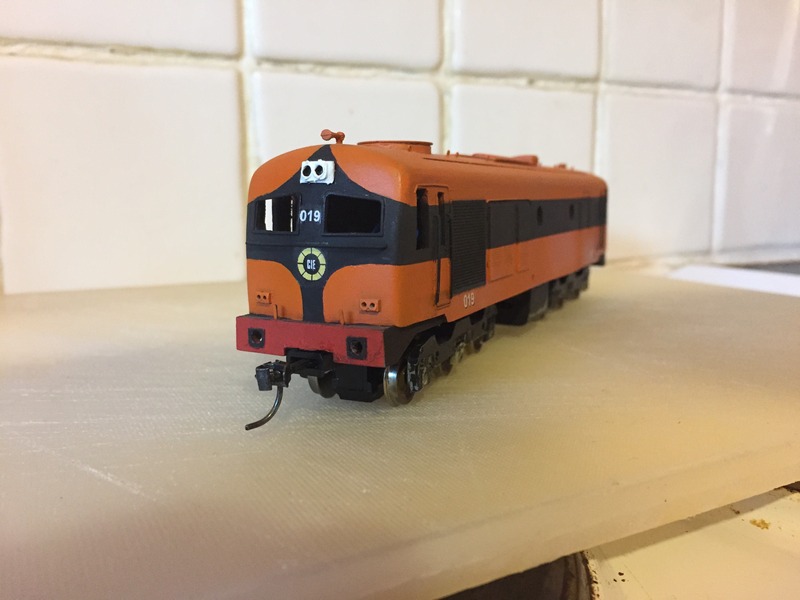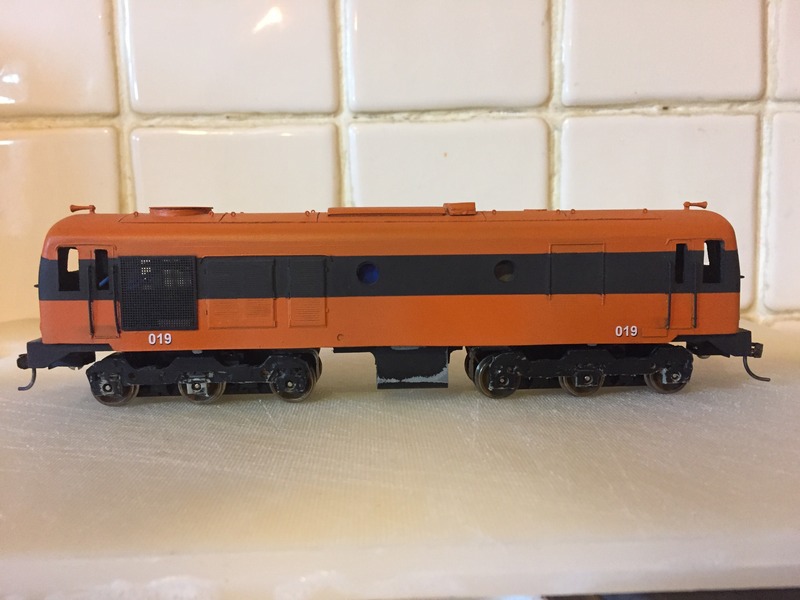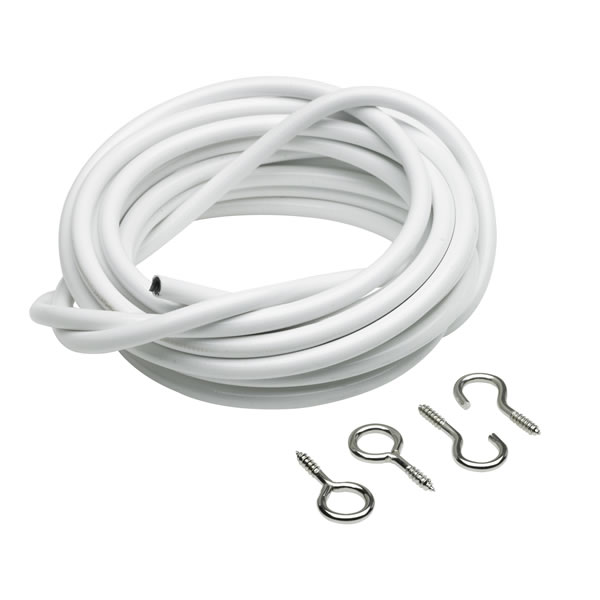
irishthump
Members-
Posts
1,849 -
Joined
-
Last visited
-
Days Won
7
Content Type
Profiles
Forums
Events
Gallery
Blogs
Store
Community Map
Everything posted by irishthump
-
Wow! I didn't realise how long it had been since my last update on my workbench but here goes... After almost 2 years the A class is nearing completion! Truth be told I did the basic paint job not long after my last post, but I only recently got around to applying Weshty's excellent decals. I still need to install the glazing and wipers, add the buffers, bogies and fuel tank detail and install the Loksound decoder.
-
Just had a listen to the videos on the site and the engine sounds are definitely the ones from ESU. My advice if you're planning on chipping a lot of locos is to by the Lokprogrammer. You can try all of these recordings yourself and just swap them out if you don't like them. I would imagine if PM goes to ESU for a sound decoder for the 121 (like he did with the 071 and 201) the sounds will be the same recordings. The tired and overhauled engine options are also easily done. There is an option to increase the playback speed of the file by small increments which raises or lowers the pitch of the engine sound.
-
Yeah I use a mixture of 12 and 16 cylinder recordings in my own locos. The number of cylinders won't make much difference to the sound though. As was said earlier it's mainly down to the higher revs of the 645.
-
That's no excuse Fran! I've been playing drums for over 25 years and at this stage I'm deafer than most and even I can hear it!
-
I assume Wheeltappers are using the recordings from the ESU website. The number of different US outline soundfiles has ballooned over the last few months. They have several versions of the 567, 645 and 710 engines. They even recently added a 567 fitted with the 645 power assembly.
-
Maybe I watch to too many Youtube videos of the different locos (a disctinct possibility!) but I notice a marked difference between the 567 and 645. There is also a subtle difference between the original 567 and the ones overhauled with the 645 power assemblies. Hard to spot, but it is there.
-
You might try looking at American HO locos. Although I don't have the dimensions to hand, I think something like an F Unit chassis might be a good fit for the C Class.
-
Jaysuz, Dave! I hope you get on the mend soon, man....
-
Which DCC sound chip for MM 141/181
irishthump replied to Noel's question in DCC, Electrics and Electronics
Noel, As I said to you before Full Throttle has both coasting and braking features. The coasting feature is activated by pressing a function key which drops the engine sound to idle while still allowing the engine speed to be controlled by the throttle. The brake function can also be assigned to a function key, when activated it brings the loco to a stop at half of the loco's programmed momentum value. If you don't have these on your loco then the supplier, for whatever reason, has decided not to activate them. -
Suitably filthy!
-
head lights not working
irishthump replied to controller's question in DCC, Electrics and Electronics
Well all I can say is that you MUST change those CV31 and 32 to access the correct function CV. If you don't then sooner or later you run the risk of changing some obscure CV which will cause the decoder to start misbehaving. -
head lights not working
irishthump replied to controller's question in DCC, Electrics and Electronics
Don't see how that's possible. CV's 256-511 need to have the register set in CV32 which can have a value of 0,1,2 or 3. Depending on what value is set for CV32 each CV above 256 controls 4 possible functions. The Procab has no way of knowing what value is needed. -
head lights not working
irishthump replied to controller's question in DCC, Electrics and Electronics
That depends on the decoder. Loksound use indexing to give the option of over 1000 possible CVs. The Powercab will NOT set the index automatically, you have to set the index CVs to the correct value with any make of controller. JMRI may do it automatically, as does the Lokprogrammer. -
head lights not working
irishthump replied to controller's question in DCC, Electrics and Electronics
Yep, Dave. But that's only if you want to access a CV above CV255. -
head lights not working
irishthump replied to controller's question in DCC, Electrics and Electronics
This can only be done by reprogramming the relevant CV's. I think the following CV changes should do the trick..... First, CVs 16 and 32 need to be given the following values. This step is very important! CV31 = 16, CV32 = 2 Then programme the following CVs like so: CV363 = 16 CV379 = 32 CV426 = 4 CV442 = 8 CV458 = 16 CV474 = 32 This should give you front and rear marker lights on F0, headlights on F1 and cab lights on F3. I don't have a Murphy's decoder so I can't verify it. If anyone can programme one to doublecheck, that would be great! Even if this doesn't work a reset will restore it to its original settings. Set CV 8 = 8. -
head lights not working
irishthump replied to controller's question in DCC, Electrics and Electronics
When you press the PROG key you will be able to scroll through 3 options. The first will say PROG TRACK. To use this mode you need to have a seperate programming track wired to the controller. The 2nd is PROG MAIN which lets you program locos while they are on the layout. The 3rd is READ PROG which allows you to read back CV values. This only works on the seperate programming track the same as the PROD TRACK option. When you press the PROG key these options will come up in the follwoing order: PROG TRACK PROG MAIN READ PROG You can just keep cycling through these 3 options until you find the one you want then press enter. If you haven't got a programming track you will have to use PROG MAIN and leave the loco on the layout. I would recomment taking every other loco off the layout until you get used to programming as it's very easy to make a mistake and for example change ALL the locos on the layout to the same address! When you select PROG MAIN press ENTER and a loco address will flash on the display. This will be whatever loco you were running last. If that's the one you want to programme, press ENTER. If you want to programme a different loco key in the address and press ENTER. The display will then show you a sequence of the most commonly programmed CV's. These will flash on the screen and you either type in a value and press ENTER to change them or just press ENTER to skip to the next one. They will display in the following order: Adr - loco address (CV1) Sv - Starting voltage (CV2) Acc - Acceleration rate (CV3) Dec - Deceleration rate (CV4) Tv - maximum voltage (CV5) After these you will see CV#. This allows you to programme whatever other CV you wish. If you enter a CV number for example CV3 which is acceleration, you scroll through to CV#, press ENTER, key in the value you want, press ENTER. CV# will flash again in case you want to programme another CV, if you don't just press ENTER which will bring back out to the driving mode on the controller. I'd recommend you try to programme the acceleration (CV3) to 0. You will be able to tell immediately if it has worked as the loco will have no momentum. You can then try programming CV3 to a large value, once again to make sure you are doing it correctly. If at any stage you get stuck and can't find your way back out of any option don't be afraid to power off the controller and start again! I've just realised how complicated this looks when written down! But once you do it a few times it becomes second nature and it's one of the simpler systems to use. -
head lights not working
irishthump replied to controller's question in DCC, Electrics and Electronics
No problem. It can be a bit daunting to attempt programming a decoder for the first time. But it is very easy with the Prodigy and I know because I use one myself! You can do all your programming on the layout but it's best to build a small programming track as this will eliminate the chances of accidentally reprogramming another loco. When you do attempt to programme a decoder if you don't like the results you can reset the decoder back to the way it was when you first got it by setting CV8 to 8. When you want to try let us know and I'll give you a list of CVs to programme that should give you front and rear marker lights on F0, headlights on F1 and cab lights on F3. -
head lights not working
irishthump replied to controller's question in DCC, Electrics and Electronics
Neither the function mapping or the function latching are adjustable in the controller. The function mapping (which function key controls which function) is adjustable by reprogramming decoder cv's. -
head lights not working
irishthump replied to controller's question in DCC, Electrics and Electronics
I can give you a list of cv's to change if you're comfortable with programming the loco yourself. -
head lights not working
irishthump replied to controller's question in DCC, Electrics and Electronics
I doubt it's either of those as they are both 4 function decoders and as Noel said you need 6 functions to get all the lights to work. They are also both 8 PIN chips so wouldn't fit the 201 without an adaptor. If you have a programming track you can read back CV8 which will give the manufacturer number, at least we'll know what brand it is. But at a guess if it was fitted by Mark's I would imagine it is the Murphy Models decoder which is an ESU. -
head lights not working
irishthump replied to controller's question in DCC, Electrics and Electronics
The problem is with the controller, the Prodigy has the F2 button assigned to be momentary function. That is it only stays on as long as the button is pressed. Double check by holding down the function key. This can be changed on some controllers but not the Prodigy. The prodigy is an American controller so it is designed to take account of the fact that most American DCC sound decoders have the horn assigned to F2. Since it was working on the Select I would say you have the correct type of decoder (6 function), but the only way to fix the problem is to assign the headlight to a different function key. This is not too difficult be we need to know exactly what brand of decoder you are using. A decoder reset will do nothing in this case. -
No, definitely not. I've converted a load of those old Athearns and doing all the hard work only to see the chip go up in smoke is enough to drive anyone round the twist!
-
For years people would'nt believe this was real, until their locos started to come apart at the seams..... It's caused by the PVA absorbing moisture which makes the lead oxidise. It can be prevented by varnishing over the PVA if the damage has'nt already occurred. This reaction only happens with lead, so if you're using fishing shot (which is no longer lead) you should be alright. I'm not sure if Liquid Lead is actually made from real lead, but I would'nt take the chance so use superglue!
-
A cheaper a more readily available alternative is curtain wire: You can use this as the tube and guitar strings make a suitable material for the wire controlling the points.
-
Fitting Enhanced Bass Relex speaker - MM 141/181
irishthump replied to Noel's question in DCC, Electrics and Electronics
Richard, here's a link to a video I posted demonstrating the Full Throttle features.... http://irishrailwaymodeller.com/showthread.php/5839-Loksound-Full-Throttle-A-quick-demo
.png.c363cdf5c3fb7955cd92a55eb6dbbae0.png)



